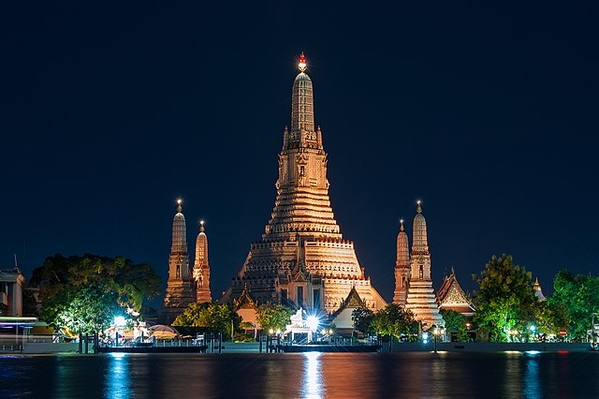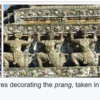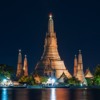As a first-time visitor to Bangkok last year, settling into our small hotel along the Chao Phraya River, one of the first distinctive sites to catch my eye was the tall spire of Wat Arun.
It's pretty hard to miss in any case, and as night fell, it became even more spectacular, with bright light directed at it.
It quickly became a reference point for my wandering around the city; when I could see it, I knew where the river was, and whether I was above or below the hotel's river location. Nonetheless, it was nearly the end of the visit and after quite a few other temples before I actually went ashore for a visit and found how much more there is besides the central tower, or prang.
A number of smaller buildings and gardens fill the area near the prang, with many people strolling through, including a number of monks from the monastery that is also part of the complex.
People (actual people) are not the only ones visible around the temple; there's also quite a bit of statuary, falling into two categories: serious and you-can't-be-serious.
And then there's the other group, clearly a current and contemporary art installation...
And, never to be forgotten in Bangkok, portraits of members of the Thai royal family, whose faces appear all over the city.
And two constructions of stone that could perhaps be called rock stars...
The elaborately-decorated prang is clearly the centerpiece of Wat Arun, but it is also a latecomer to the scene. A temple, Wat Makok, was first built on the site in the mid-1600s, when Ayutthaya was the capital. After the defeat of the Ayutthaya Kingdom,
Taksin, a general, created a new capital in Thonburi, now part of Bangkok, and renamed the temple Wat Arun, after the Hindu god Aruna. He also placed the famed 'Emerald Budha' in the temple, although it was moved in 1785.
Taksin's successor, Rama I, moved the capital across the river in 1785 along with the statue, and left the temple abandoned. His successor, Rama II, did an about-face and planned to renovate and expand Wat Arun; the central prang and its four neighboring spires were his plan, but not built until the 1850s under Rama III.
A series of reconstructions, renovations and extensions took place in the 1890s, 1976, 2012 and 2016, with each one taking a slightly different approach to the colors and tones of the decoration. You can see a comparison of some recent work in the Wikipedia clipping below, and an up-close view of the current appearance in my last photo.





Comments (1)